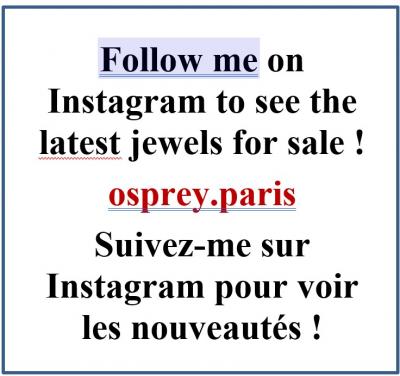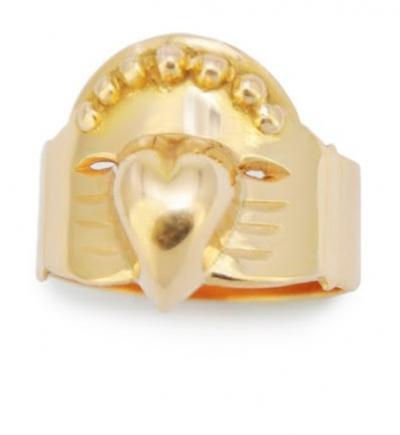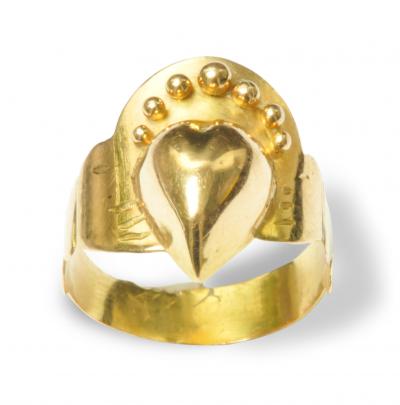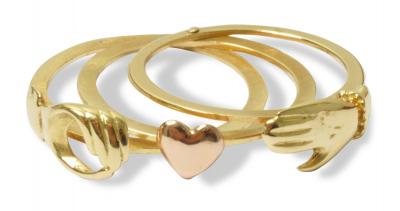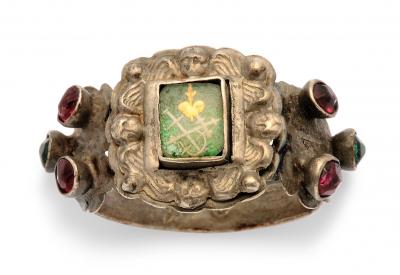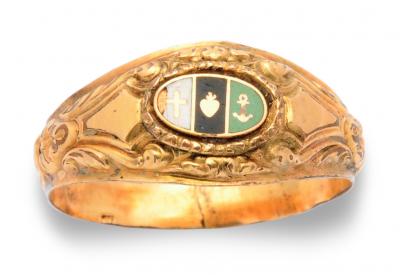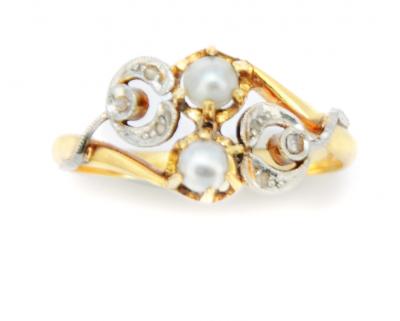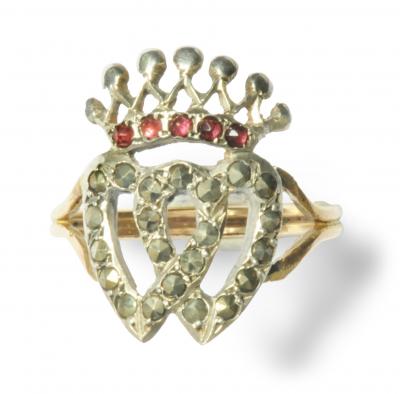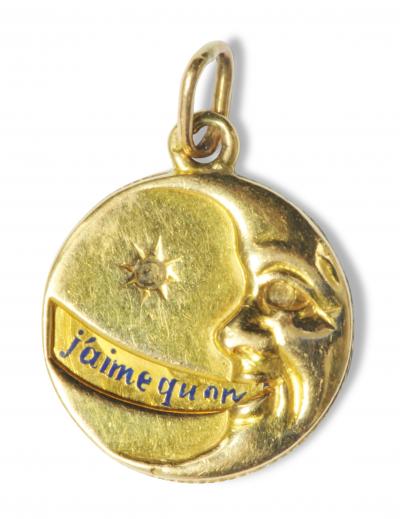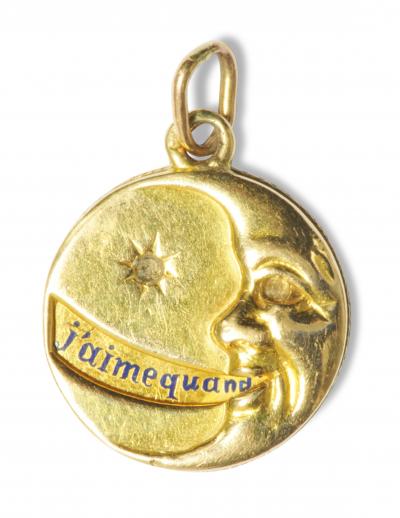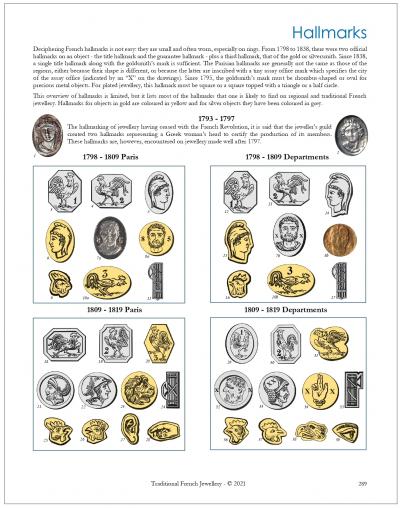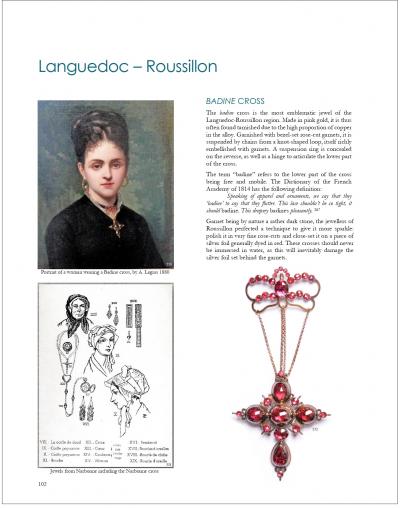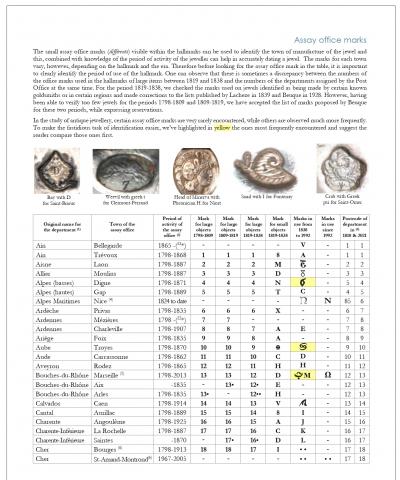Engagment

The engagement
|
Between the 17th and 19th century, the traditional engagement ring in France was the faith ring (or fede ring) or the Promesse ring. The faith ring has a design of either two holding hands (sometimes holding or hiding a heart), or of two joined hearts, generally set below a crown. The Promesse ring, generally in bronze but sometimes in silver, has an oval cartouche without any stone and is engraved with either religious symbols or a heart with an L or a V. The heart with an L represents “mon coeur est à Elle” or “Elle a mon coeur” (my heart is with her or she has my heart) while the V with a heart represents “Mon coeur est à Vous” (You have my heart or my heart is with you). Promesse rings dating from the 17th century are still sometimes uncovered in the native American sites of the northern USA and Canada where they were once popular trading goods with the native Americans.
Before 1800 diamond rings were rare and belonged to wealthy persons. The tradition of the diamond engagement ring didn't exist in France before around 1880. While there was a fashion in the 18th century for members of the aristocracy to wear rings set with a pointed diamond, so-called "scribbler rings" which were used to engrave one's initials or a phrase into mirrors or window panes, the engagement ring for most people before 1880 was generally in bronze or in silver without any precious stones, the design of which varied according to the region.
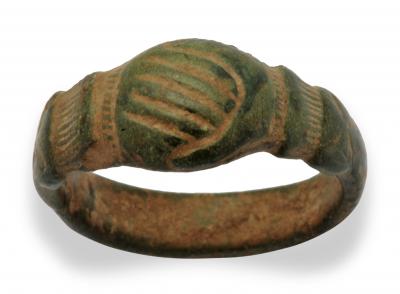 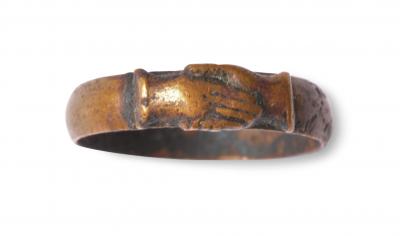
faith rings, bronze (200%)
|
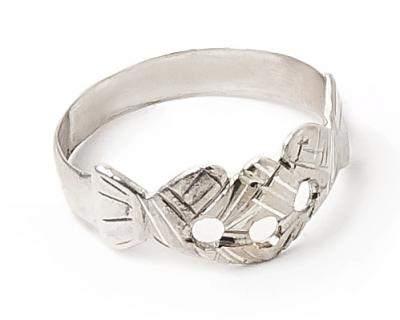
faith ring (bague de foi) in silver
|
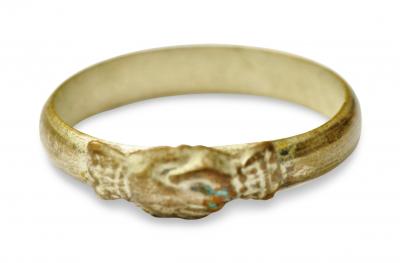
faith ring (bague de foi) in silver-plated brass
|
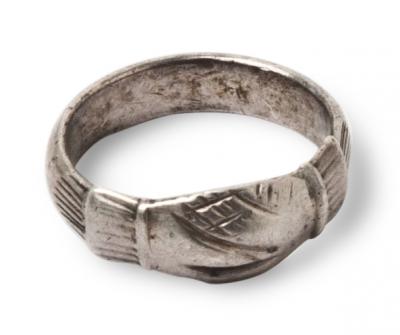
faith ring (bague de foi) in silver
|
|

wedding photo circa 1900
|
150%
faith rings (bagues de foi) in gold - note how the hands have evolved into mere lines (150%)

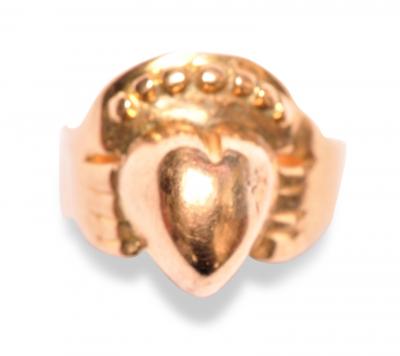
two faith rings (bagues de foi) gold (200%)
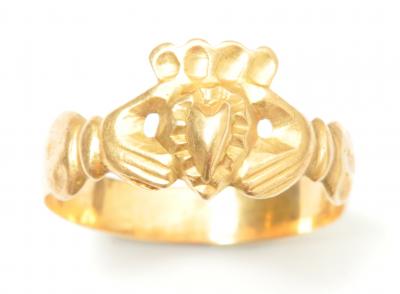
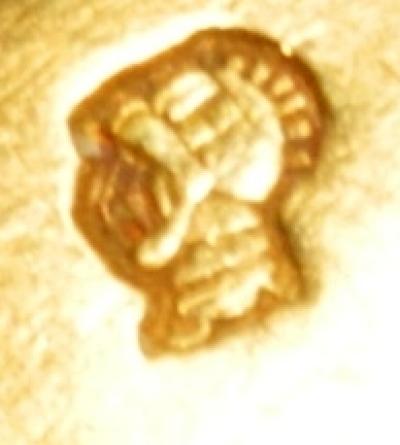
faith ring (bague de foi) gold (200%)
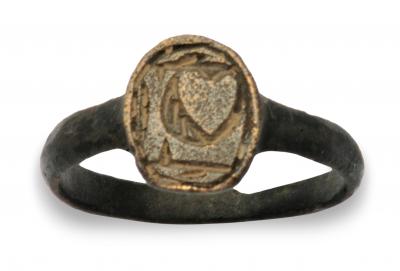

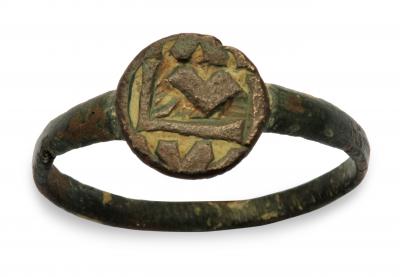
promesse rings in brass, 17th - 18th century : the L heart symbol represents"Elle a mon coeur" (my heart is with her)

promesse ring in silver, 18th - 19th century : the L heart symbol represents"Elle a mon coeur" (my heart is with her or she has my heart)
|
|

"Duchess Anne" ring in gold, very worn
|
|
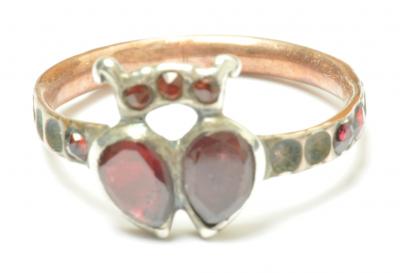
"Duchess Anne" ring in silver and garnets
|
|
|
|
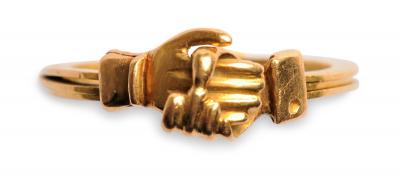
bague en or en trois parties ouvrant pour reveler un coeur, moderne
|
|
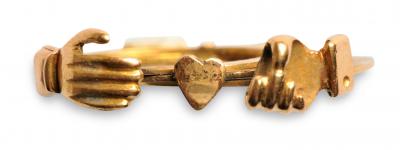
bague en or en trois parties ouvrant pour reveler un coeur, moderne
|
|
antique gimmel ring in gold made of three hinged rings which slide open to reveal a heart
modern copy of an antique gimmel ring in gold made of three hinged rings which slide open to reveal a heart
In Brittany and southern Normandy the silver ring "à la duchesse Anne" with two hearts and seven coloured garnets was very popular between 1800 and 1880 as an engagement ring. On silver rings one or both of the two hearts was generally gold plated.
|

bague "à la duchesse Anne" en argent et grenats
|
|
|
|
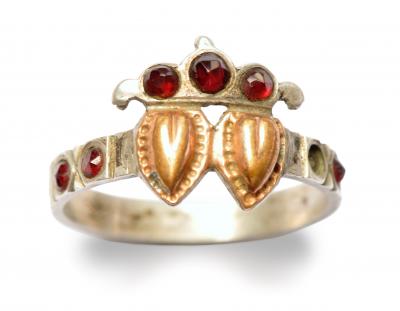
bague "à la duchesse Anne" en argent et grenats |
"Duchess Anne" rings in silver set with garnets, 1819-1919
|
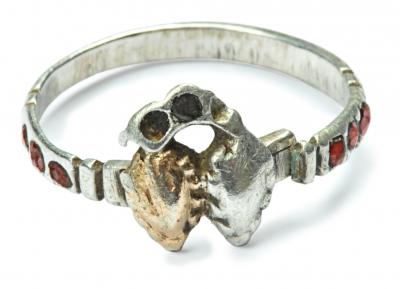
"Duchess Anne" ring in silver
set with garnets, 1809-1819
|
|

"Duchess Anne" ring in silver
set with garnets, 1809-1819
|
|
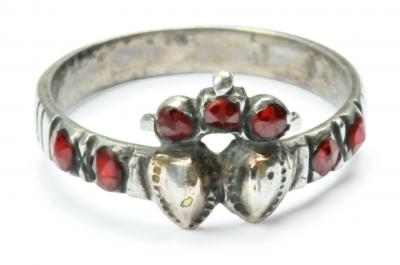
"Duchess Anne" ring in silver
set with garnets, 1809-1819
|
Three engagement rings from the Messe region in eastern France, two in gold-filled and one in silver
note the four evangelists around the engraved glass of the silver ring
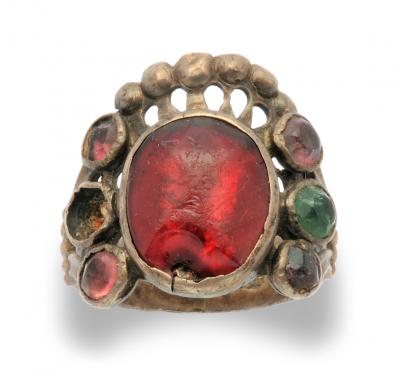
Traditional engagement ring from Strasbourg known as "la paysanne" in silver and glass

Engagement ring à l'anglaise in silver and glass
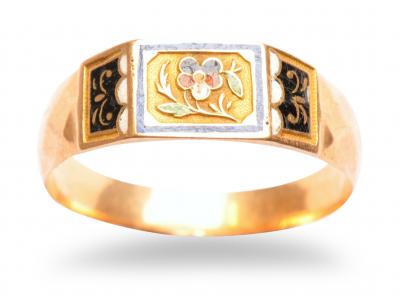
Men's engagement ring with pansy motif, enamelled gold

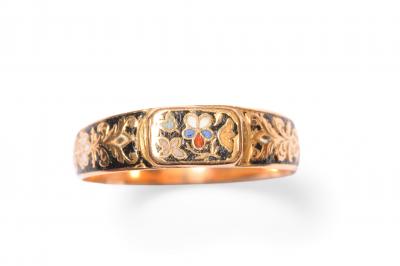
Men's engagement rings with pansy motif, enamelled gold (150%)
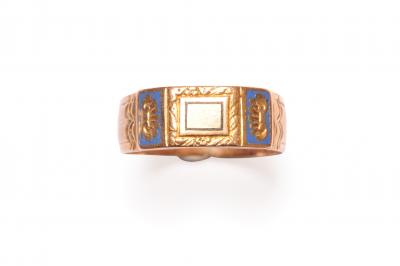
Men's engagement ring in enamelled gold (150%)
|

antique ring set with rose cut diamonds
circa 1810-1830

antique ring set with tiny diamond, c1900
|
The word diamond comes from the Greek adamas, meaning un-tameable, un-conquerable or unbreakable and it's the combination of the longevity of the diamand that one can wear for a lifetime with no visible wear and its symbolism with the strength and unity of marriage that made its use in engagement rings indispensable.
The first diamond engagement rings for the middle and lower classes were set with one or several minute diamond chips, ranging in size from one two-hundredth to one fiftieth of a carat. These diamands were truly chips; fragments coming from a larger diamond during the cleaving process and set in the ring without any prior polishing. Today the term "chip" is still used for very small diamonds, even though the "chip" is fully cut with 57 facets.
In the eighteenth and nineteenth century it was a big moment in the life of a young man or a couple to set out to see the jeweller and buy the engagement ring, and, in many cases, several other jewels. For a farmworker it was probably the first time he had set foot in a jeweller's shop and was obviously a moment of great trepidation and anticipation. An engagement ring, even in silver, was an important purchase at a time when most people had little or no surplus revenus and so the negotiations were generally long. Often a quantity of gold was offered to the couple by their parents to be brought to the jeweller and transformed into the new jewellery so coveted by the bride-to-be. The resultant trousseau was called "la mise" in Normandy while in the north of France the trip to the jewellers was called "aller à dorlots", dorlots being reverse slang for "lots d'or" (quantity of gold).
The parure of jewellery worn by the wife was a source of pride for the couple, which demonstrated to others their level of prosperity and they would try during their lifetime to hold onto it and to add to it whenever possible. Banks were not trusted by much of the population who had heard of the failure of John Law's Royal Bank, in 1720 and the fiasco of the assignat paper money in 1795, and gold, whether in the form of jewellery or Napoleon gold coins, was an easily negotiable store of wealth. In a time when there was no social security, the only way to get through hard times unless one had help from the family was by selling or pawning one’s gold.
|
Today a much smaller part of a couple's wealth is spent on engagement jewellery in France than in the past and the one carat diamond which is pretty much the basis in North America is rarely purchased in France.
In the jewellery shops situated in the shopping malls connected to supermarkets, the engagement ring budget tends to be between €300 and €500, while in the stand-alone jewellers in the town centre, the average budget is a bit higher.
In some cases, people with low incomes will make do with an aquamarine or amethyst ring costing €150. |
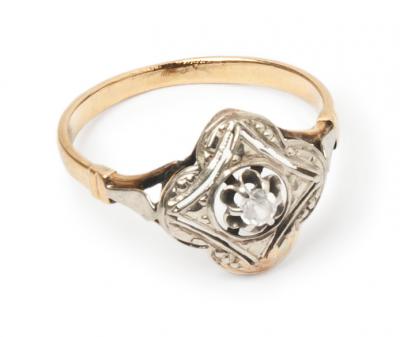
gold enagement ring set with a tiny diamond chip, c1900
|
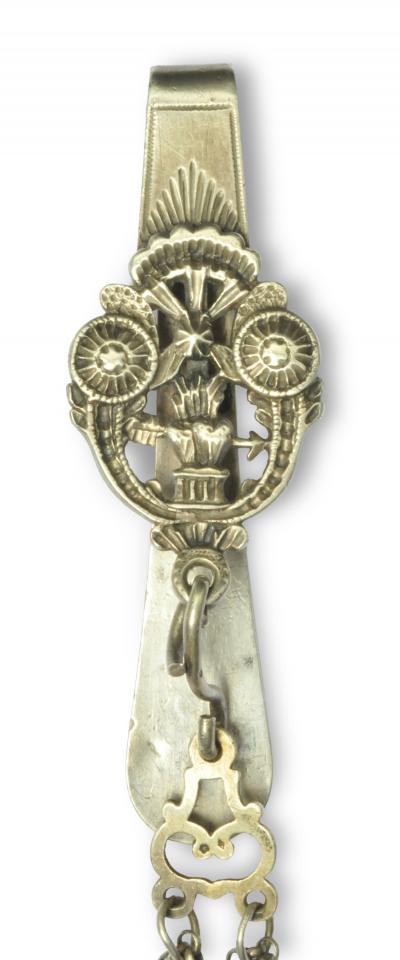
silver belt-clip or chatelaine decorated with two burning hearts on an altar, pierced by an arrow
and offered as an engagement or wedding present in the region of Nîmes
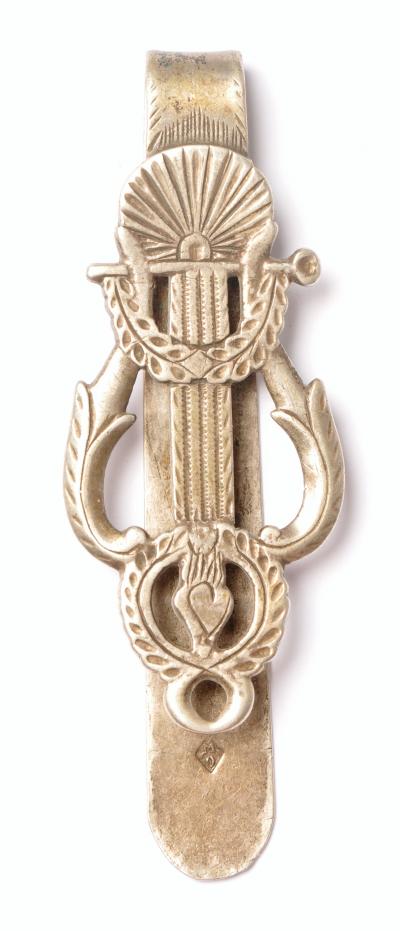
silver belt-clip or chatelaine decorated with a burning heart

slave necklace with motif of two burning hearts on an altar, gold and blue enamel

detail of slave necklace with motif of two burning hearts on an altar, gold and blue enamel, enlarged 200%

Silver châtelaine plated with three colours of gold and decorated with a basket of flowers, a flaming torch and a quiver of arrows
Offered as a love token for an engagement or wedding present, collected in Normandy.
Flowers have always been popular motifs for love tokens and there is an antique verb "fleureter" which comes from "fleurette". The old dictionaries give the following definition : Fleurette, a little compliment where the flowers are both the pretexte and the terms of comparison. A shame that this lovely word has been lost and replaced by the English derivative flirt.......

18th century gold-plated snuff-box with motifs of cupid and fidelity
gold love medal with a turning disk revealing three phrases (200%)
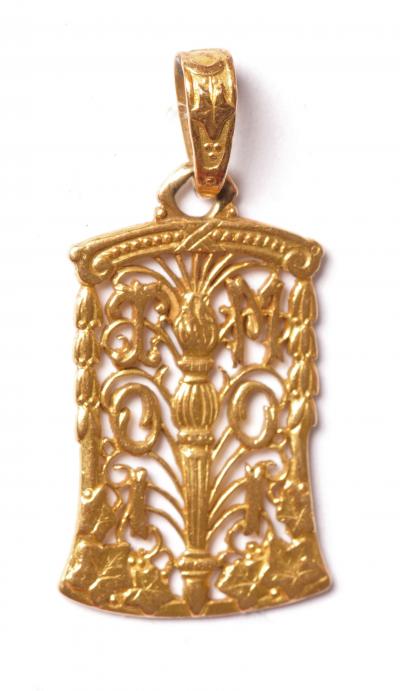
pendant "Toi et Moi" (you & me) in hand-cut gold, enlarged 200%
The engagement
Table of contents
bague de fiançailles, bague de foi, bague à la Duchess Anne, alliance en or, ivoire de Dieppe, argenterie, métal argenté, argent massif, ménagère en argent, manche à gigot, pelle à tarte, pince à sucre, louche, cuillère à ragout en argent XVIII, sucrier en argent, service de baptême en argent, théière en argent, rince doigts en argent, Christofle, Tiffany, Têtard Frères, Fabergé, Mappin and Webb, cafetière en argent, chocolatière en argent, plateau en argent, argenterie art déco, argenterie art nouveau, manches a côtelettes en argent, service à découper en argent, service à confits, cuillère à Absinthe, saupoudreuse en argent, passe thé en argent, verseuse en argent, casserole en argent, bijou régional, bijoux régionaux, bijoux et orfèvres en Haute-Normandie, bijoux des régions de France, costume régionale, coiffe, Streeksieraden in Zeeland, Freisland, bijoux de deuil, bague de deuil, collier de deuil, bague en cheveux, bracelet de deuil, bracelet en cheveux, collier en cheveux, croix de deuil, bijoux en jais, boucles d'oreilles en jais, parure de deuil, broche de deuil, broche en cheveux - Les ouvrages en cheveux par Andrée Chanlot - antieke sieraden - bague de foi, alliance de mariage, bague de fiançailles, bague marguerite, bague diamant, bague normande, bague capelet, bague tank, bague de deuil, bague des tranchées, bague des poilus, bague en aluminium, bague romaine, bague pensée, bague toi et moi, bijou régional, bijoux régionaux, les bijoux traditionnels Français, bijoux et orfèvres en Haute-Normandie - bijou normand - bijoux normands - boutons de manchettes or anciens, bouton manchettes argent, chevalier or, chevalier ancien, bague intaille or, boutons de col, boucles de chaussures argent et strass, boucle de col, agrafe de corporation, étui à cartes de visite, étui à allumettes, montre gousset, chaine de montre, bijoux de chasse, bijoux masculins, bijou régional, bijoux régionaux, les bijoux des français, boucles d'oreilles Milanos, pendants d'oreilles Milanos, boucles d'oreilles jais, boucles d'oreilles de deuil, boucles d'oreilles anciennes, boucles d'oreilles en or, boucles d'oreilles régionaux, boucles d'oreilles normandes, boucles d'oreilles Poissards, boucles d'oreilles sablais, boucles d'oreilles en filigrane, boucles d'oreilles savoyards, boucles d'oreilles créoles anciennes, boucles d'oreilles provençales, boucles d'oreilles auvergnats, boucles d'oreilles bretonnes - bracelet ancien, bracelet tank, bracelet époque Restauration, bracelet art nouveau, bracelet art deco, bracelet régional, bracelet grenat, bracelet provençal, bracelet normand, bracelet savoyard, bracelet breton, bracelet de deuil, bracelet de baptême, bracelet de communion, bracelet en cheveux, bracelet traditionnel, collier dite d'esclavage, chaine sautoir, collier draperie, chaine en or, chaine de montre, chaine ancienne, collier Tubogaz, collier art deco, collier de perles, collier Saint Esprit, sautoir en or, sautoir 'sorcière'- crochet de châtelaine à ciseaux en argent - croix huguenote, croix bosse, croix drille, quadrille, croix de pierres, croix de Rouen, croix de Puy, croix d'Auvergne, croix de Velay, croix de Bresse, croix Jeannette, croix de Lorraine, croix de Savoie, Croix plate des Villards, croix plate des Villars, croix de Saint Lô, croix de Caen, croix de Boulogne, croix du Portel, croix capucine, croix Maintenon, croix de Nice, croix plate, croix Marie Antoinette, croix Louis XVI, croix écotée, croix bretonne, croix de Faucigny, croix pattée, croix fleuri, croix de Valloire, croix reliquaire, croix d'Arles, croix fleuri, croix en corail, croix émaillé, croix dévote, croix en corail, croix à pendeloques, larmes de Jésus, croix de Champagne, croix papillon, croix flamande, croix de communion, croix de baptême, croix en ivoire, croix de berceau, croix picarde, croix en or, bijou régional, bijoux régionaux, bijoux et orfèvres en Haute-Normandie, bijoux des régions de France, costume régionale, coiffe, croix baton, croix de communion, croix en ivoire, - épingle ancienne, épingle époque Restauration, épingle art nouveau, épingle art déco, épingle régionale, épingle grenat, épingle provençale, épingle normande, épingle savoyarde, épingle bretonne, épingle de deuil, épingle en cheveux, épingle traditionnel, épingle bébé, épingle diamant, épingle camée, épingle en ivoire, épingle porte photo, épingle en email plique-à-jour, épingle perle, épingle limousine, épingle corail, épingle de nourrice, les bijoux traditionnels français - Pieter van Abeele - pendentif ancien, pendentif époque Restauration, pendentif art nouveau, pendentif art déco, pendentif régionale, pendentif grenat, pendentif provençal, pendentif normand, pendentif savoyard, pendentif breton, pendentif de deuil, pendentif en cheveux, pendentif traditionnel, pendentif bébé, pendentif diamant, pendentif flamand, pendentif camée, pendentif en ivoire, pendentif porte photo, pendentif en email plique-à-jour, pendentif perle, pendentif limousin, pendentif corail, pendentif Saint Esprit, Saint Esprit normand, Saint Esprit de Puy, Saint Esprit Clermont Ferrand, Saint Esprit de Velay, griffe de tigre, griffe de lion
The engagement
New book - Traditional French Jewellery
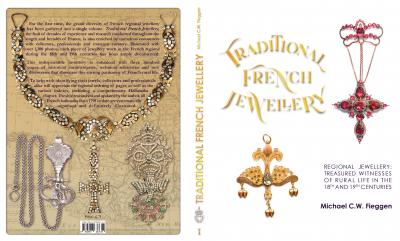
Book - Traditional French Jewellery - order here direct from the author
Dear collectors, auctioneers, dealers and jewellery lovers,
You have visited the site www.bijouxregionaux.com which since 2009 has listed all regional and traditional French jewellery, without advertising and without sales. By popular demand, this website is now finally available as a book, much more complete and with many new photos and texts that are not on the site. I traveled more than 4,500 km in 2020 to visit the various collectors and museums of France and to photograph, weigh, measure and examine their jewellery.
Large format of 23.5 x 30 cm, 304 pages, hardcover and fully illustrated with over 1300 jewels in color, this book is the first complete book on French regional jewellery and corrects the many errors and gaps observed in the other references and presents other regional jewels hitherto unknown to the public. You will find eight full pages on Breton pins and fibulae and many other jewels in museums and private collections that are not on this website. Over four months of research has gone into making the chapter on hallmarks the most reliable ever seen - clear illustrations of hallmarks have been made especially for this volume. And for the first time, collectors will have access to a complete list of all the assay office symbols, small signs withn the hallmarks that identify in which city the jewellery was hallmarked. The opening and closing dates since 1798 of the hallmark offices are also listed for the first time, allowing, with the office symbol, to better date your jewellery.
The print run of this book is very limited, which is why I recommend you order early. You will love this book I have had nothing but compliments and many clients have ordered more to offer as gifts.
To order, you can send a wire transfer or WISE transfer to Michael Fieggen - FR76 4061 8803 9700 0403 3233 171 – BIC – BOUSFRPPXXX - address Mike Fieggen, 280 rue Saint Honoré, Paris, 75001 France
Bank or wire transfer by www.wise.com in Sterling – Account holder - Michael Fieggen
IBAN - GB68TSBS30916200184462 BIC / SWIFT - TSBSGB2AXXX
Sterling cheques and PayPal welcome to address demosthenesparis@gmail.com.
Any questions ? Contact me at bijouregional@gmail.com or by telephone at + 33 1 4015 9000
One copy in French €75 Postage and packing €9 for France, €8 for Europe and overseas
Two or more copies in French €75 each Postage and packing €9 for the lot in France, overseas postage €8 each
One or more copies in English £75 sterling each Postage and packing £8 sterling each
